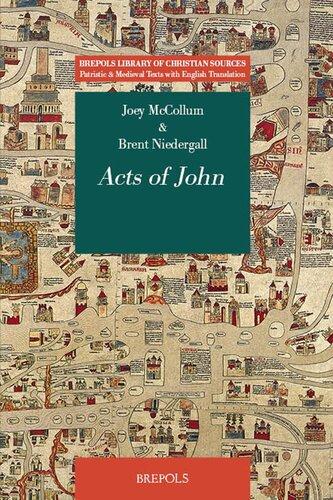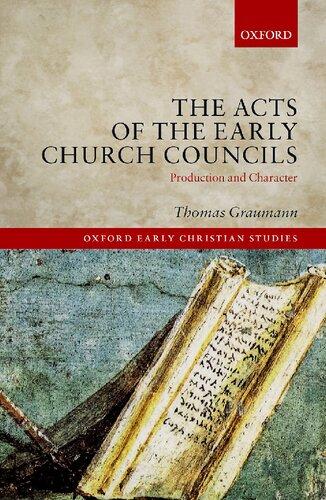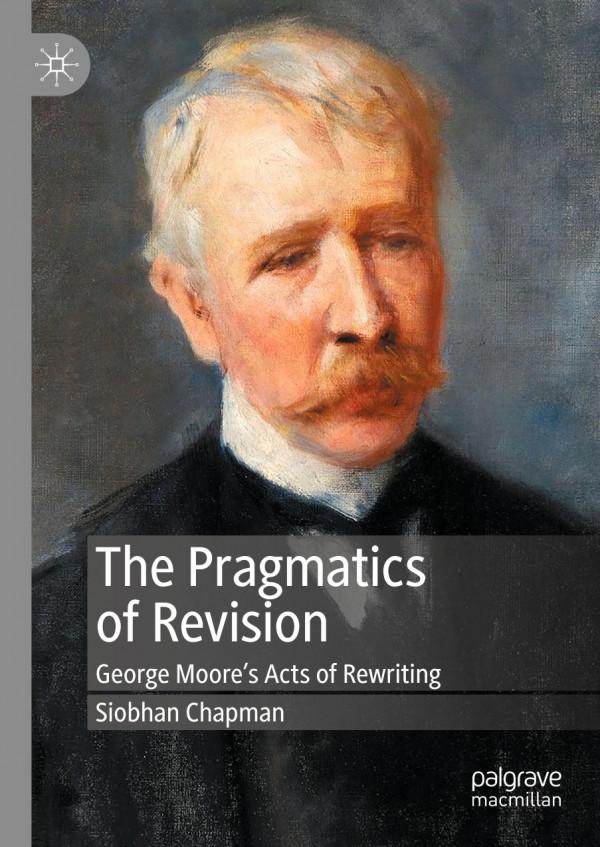Acts of John
Translated by Joey
McCollum and Brent Niedergall
with the assistance of Derek G. T. DeMars, Bobby Howell, and Stephen M. Young
Cover image: Ebstorfer Mappa mundi © Kloster Ebstorf. Used with permission.
© 2022, Brepols Publishers n.v., Turnhout, Belgium.
All rights reserved. No part of this publication may be reproduced, stored in a retrieval system, or transmited, in any form or by any means, electronic, mechanical, photocopying, recording, or otherwise without the prior permission of the publisher.
D/2022/0095/153
ISBN 978-2-503-60016-1
eISBN 978-2-503-60017-8 ISSN 2736-6901 e-ISSN 2736-691X
DOI 10.1484/M.BLCS-EB.5.128870
Printed in the EU on acid-free paper.
Abbreviations
CCA Corpus Christianorum Series Apocryphorum
ECA Early Christian Apocrypha
JTS Journal of Teological Studies
LSJ Liddell, Henry George, Robert Scot, and Henry Stuart Jones. A GreekEnglish Lexicon. 9th ed. with revised supplement. Oxford: Clarendon, 1996.
MSJ Master’s Seminary Journal
NTS New Testament Studies
SBLMS Society of Biblical Literature Monograph Series
VC Vigiliae Christianae
Introduction
Date
Te Acts of John is a second or third-century work belonging to the genre of apocryphal acts narratives. It was most likely composed of “foating” traditions from multiple sources of varying levels of orthodoxy.1 Tus, it comes as no surprise that both Eusebius (Hist. eccl. 3.25.6–7) and Augustine (Ep. 237) labeled the work heretical.2 While these patristic references allow us to place the composition of the work no later than the fourth century, there are few clues that allow us to date it with any further precision. A reference to the third Temple of Artemis sufering damage or destruction (c. 42) is, unfortunately, of litle help, because the date of the temple’s fnal destruction is unknown.
Authorship
Only the ninth-century patriarch of Constantinople, Photius, ventured to atribute the work to an author. His claim was that one Leucius Charinus, a name also associated with several other apocryphal acts narratives, composed the book.3 According to Epiphanius, Leucius Charinus was a follower of the apostle John (Adv. haer. 51.427), but whether he actually wrote the Acts of John is purely conjecture.
Contents
Ascertaining the original text of the Acts of John is no easy task. An early description in the Stichometry of Nicephorus measured its length at 2500 stichoi, the approximate length of the Gospel of Mathew.4 Unfortunately, the textual tradition of the Acts of John has seen numerous interpolations and redactions of entire passages, so even verifying the length of the work is out of reach. Te chapters that have survived are not preserved entirely in any one manuscript, so scholars have had their work cut out for them sorting out all of the material.
1 Elliot 1993, 306.
2 Elliot, 303.
3 Meeks 2016.
4 Elliot, 303.
In this translation, we follow the reconstruction from the critical text of Junod and Kaestli (1983). A brief overview of the contents can be found in Table 1 below.
Table 1: Overview of the extant contents of the Acts of John, following the critical reconstruction of Junod and Kaestli (1983). Te common sigla for the manuscripts of the Acts of John are used in the “Primary witnesses” column; more detailed descriptions of the manuscripts can be found in Junod and Kaestli (1–107) and Elliot (303–06, 310–11). Te chapter numbers are those of Junod and Kaestli.
Chapters Primary witnesses
18–36 R, Z, and parts of H
87–105 C
37–55 R, Z, and parts of H
56–57 L and S
58–86 R, Z, and parts of H, O, M, and the Latin version of the Virtutes Iohannis
Description
John raises Lycomedes and Cleopatra; the portrait of John; the healing in the theater
John’s recollections of the polymorphous nature of Jesus; the Hymn of Christ; the vision of the cross
Showdown at the Temple of Artemis; resurrection of the priest of Artemis; murder and resurrection in the countryside; departure from Ephesus to Smyrna
Exorcism of the sons of Antipatros
Return to Ephesus; the well-behaved bedbugs
106–15
Tree Greek recensions and several ancient-language translations
Drusiana and Callimachus; John’s farewell address and departure (also called the Metastasis)
Even the text as reconstructed above is fragmentary, with multiple gaps separating the sections. Te original beginning (preceding what is c. 18 in Bonnet’s numbering) is likely lost to history, and the chapters numbered 1–17 by Bonnet are now deemed to be secondary.5 Te pericope of the healing in the theater has been truncated at c. 36, and the subsequent story detailing the conversion of Andronicus is missing, as are the introduction of Andronicus’ wife Drusiana and the stories of her resurrection and conversion between cc. 36 and 87.
A gap is also present between c. 105 and c. 37, which Junod and Kaestli suspect contained many lost pericopes. Te only Greek manuscript extant at c. 105 (C)
5 Elliot, 304.
concludes with a doxology, as its text ends here. Other gaps surely included stories of John’s travels before he met Antipatros (between c. 55 and c. 56) and his travels to Smyrna and the surrounding cities (between c. 57 and c. 58). Based on the incipit of c. 58, this gap also included a trip to Laodicea.
Several other isolated accounts can be found in the tradition of the Acts of John, but these are believed to be later accretions to the text (and as such are not translated here). In one part of the tradition (manuscript Q), the story of John and the partridge takes the place of the story concerning the sons of Antipatros (cc. 56–57); while many editors prefer the former pericope, Junod and Kaestli consider the later to be original (25, 145–58), and Elliot (326–27) prints both. Tree other pericopes, which detail John’s intercession for a priest ensnared in sin, John’s turning hay to gold, and John’s encounter with the devil in the form of a soldier, are only fully preserved in a ffeenth-century Irish manuscript, but Junod and Kaestli note that the fourth-century Oxyrhynchus Papyrus 850 appears to atest to some early form of the frst and third of these pericopes (109–36).
It is debated whether the sections showing a more Valentinian Gnostic or docetic infuence (specifcally, the sections in cc. 87–105 preserved in manuscript C) were interpolated, or if they were original to the work. As we discuss in more detail in the next section, traces of Valentinian theology may be identifed outside of cc. 87–105, so the hypothesis of the originality of these chapters may be viable. In any event, Junod and Kaestli retain these chapters in their critical text, so we have translated them here. Due to discrepancies in the textual tradition and in editors’ judgment, the chapter numbering of the Acts of John has accumulated discrepancies of its own from edition to edition. For the convenience of the reader, we detail the diferences between major editions in Table 2 below.6
6 Te editors wish to acknowledge that they are aware of Richard Pervo’s 2001 criminal charges and subsequent conviction for possessing and distributing child pornography. We unequivocally condemn this behavior and wish to clarify that Pervo’s work is cited where necessary because it is the most recent English translation of the Acts of John of which we are aware.
Table 2: Chapter numbering diferences across editions of the Acts of John . Since most editions since Bonnet have used his chapter numbering as a basis, the rows are keyed to chapter numbers in his sequence. Specifically, the first row for cc. 56–57 corresponds to the pericope of John and the partridge, while the second row corresponds to the pericope of the sons of Antipatros. A dash indicates that a given edition lacks the chapters in question. The 1880 edition of Zahn is not included, as it does not number the chapters of the Acts of John . The present translation follows the numbering of Junod and Kaestli’s 1983 edition.
Elliot, 1993 Pervo, 2015
(Unnumbered, included in note afer 36)
Bonnet, 1898 James, 1924 Junod and Kaestli, 1983
Keep numbering of 87–105, but relocate afer 36 Keep numbering of 87–105, but relocate afer 36 Keep numbering of 87–105, but relocate afer 36
(Unnumbered, included in note afer 55)
87–105 87–105
Interpretation and Exegesis
Te Acts of John features many citations and allusions to texts from the Old Testament and Gospels, as well as several potential references to New Testament epistles and deuterocanonical texts. (For convenience, we have highlighted all suspected allusions and citations in our footnotes.) Trough its interpretation of these scriptures and through its own narrative, the Acts of John ofers a window into early Christian belief and practice. Some the practices and beliefs expressed in the Acts of John would later wane in popularity. Fasting is described as an act representative of spiritual maturity (c. 29) and Christian community (c. 84). On multiple occasions, the protagonists of the narrative exemplify the virtues of celibacy, even within marriage (see cc. 34, 68, and 113). In general, the author of the Acts of John holds a low view of the body, associating it with corruptibility and death (cc. 29, 35, 77, 84), and a high view of the spirit, praising those who endure physical hardship in faith and deny earthly “obstacles,” including children and parents (cc. 34, 68–69).
Tese general beliefs occasionally venture into the territory of unorthodox theology. A docetic view of Christ (i.e., that his physical nature was not real, but merely apparent) is clearly expressed throughout cc. 87–105 (the section preserved exclusively in manuscript C), and in connection with this view, we see a strong emphasis on the polymorphism of Christ in the same section.7 Te theology of cc. 94–104 has been connected with Gnosticism, and more specifcally with Valentinian Gnosticism.8 We fnd an explicit mention of the Ogdoad and potential references to specifc Aeons, as well as the Valentinian concept of the cross as a limit (ὅρος) separating upper and lower realms of existence and the rejection of Jesus’ physical sufering common to Gnostic literature. In light of the content of this section, the very seting of John’s revelation concerning the cross takes on the character of a Gnostic initiation.
Yet while the rest of the Acts of John seems to assume a far more orthodox theology than cc. 87–105, there are a few places in the main text where traces of docetic and Valentinian ideas may also be found. Polymorphy is again atributed to Christ in c. 82, and even to Satan in c. 70. Te condemnation of Fortunatus in c. 84 also uses terminology strongly reminiscent of Valentinian theology (for more detail, see our notes in that chapter).9
7 For more on this subject, see Foster 2007 and Lalleman 1995.
8 Junod and Kaestli, 589–632; for more on these subjects, see Pagels 1979, Brakke 2010, and especially Pagels 1973.
9 For an overview of similar Gnostic ideas found throughout the Acts of John and a discussion on how the entirety of the Acts of John might be read through a Gnostic lens, see Lutikhuizen 1995.
In addition to serving as the focal point of docetic and Gnostic infuence in the Acts of John, the narrative in cc. 87–105 (which consists of John recollecting his experiences as a disciple of Jesus) also ofers the greatest insight into the author or redactor’s (re)interpretations of the canonical writings. First, as Bauckham (2006) has noted, the Acts of John is one of the earliest surviving writings to associate John the beloved disciple with John the son of Zebedee explicitly (463–64). Tis identifcation is made between two separate recollections in cc. 88–89.
Te account of Jesus’ transfguration in c. 90 adds several details to its parallels in the Synoptic Gospels so as to advance a polymorphic Christology, but one relatively mundane point it stops to note is potentially much richer exegetically: John catches a glimpse of the divine Jesus, but only with his eyes to Jesus’ back. Tis appears to be an allusion to Moses’ experience of seeing God (though not face-to-face) on Mount Sinai in Exod 33:23. If this is indeed the case, then it would furnish a critical interpretive distinction between the transfguration account in the Acts of John and its counterparts in the Synoptics: while the Synoptics cast Jesus alongside Moses and Elijah as a new and greater prophet, the Acts of John puts John in the place of Moses and Jesus in the place of God.
Other pericopes in this section give the impression that they were writen to add new color to the old, familiar stories of canonical Gospels or to answer certain questions that readers might have had about the details. What were Jesus’ meals with the Pharisees like? What hymn did Jesus sing with the disciples afer the Last Supper (as Mark 14:26, Mat 26:30, and Luke 22:39 note in passing)? Was John indeed present at the crucifxion (as the fourth Gospel purports), or did he abandon Jesus with the rest of the disciples (as the Synoptics suggest)? In cc. 87–105 of the Acts of John, we fnd creative answers to all of these questions.
Translation
For this project, we were fortunate to have the shoulders of many giants available for our feet. Te Acts of John has a rich history of translation into various languages. Even among English translations alone, the editions of James (1924), Elliot (1993), Ehrman (2003), and Pervo (2015) are not exhaustive. For the facing-page Greek text and the basis of our translation, we relied upon the critical edition of Junod and Kaestli (1983), consulting other translations when we needed to compare their handling of difcult passages. Te critical apparatus and extensive commentary by the editors made Junod and Kaestli’s work an indispensable resource at every stage of the translation.
Tis translation was a collaborative efort of fve students and independent scholars. Blocks of chapters were assigned to team members for an initial translation. Initial translations were reviewed in a second pass by another translator. For each block, Joey McCollum performed a fnal pass to ensure stylistic consistency. Table 3 outlines our division of work.
Table 3: Division of chapters for first and second translation passes.
Chapters
First Pass
Second Pass
18–25 McCollum Niedergall
26–29 Young McCollum
30–36 McCollum Niedergall
87–93 Niedergall McCollum
94–102 McCollum Niedergall
103–05 Niedergall McCollum
37–47 DeMars McCollum
48–55 Howell Young
56–57 McCollum Niedergall
58–61 Howell McCollum
62–71 Niedergall McCollum
72–80 McCollum Niedergall
81–86 Niedergall McCollum
106–15 McCollum Niedergall
Our translation technique tends towards formal equivalency while preserving renderings that sound natural in English. Where possible, we sought to preserve wordplay found in the original Greek (e.g., cc. 57, 84, 96, and 112). We used gender-inclusive
language, translating ἄνθρωπος as human or person by default, except where man was warranted by context or style. In the context of the Eucharist, we translated ἄρτος as loaf over against bread as long as this allowed for natural-sounding English.10 Hugh A. G. Houghton’s work on prayer in the apocryphal acts provided helpful perspective on the typical framing of prayers in early Christian literature.11 In general, we erred on the side of verbosity, adding explanatory footnotes wherever we thought they might be helpful; we sincerely hope that they serve their purpose.
10 O’Loughlin 2004.
11 See Houghton 2004.
Acknowledgements
We would like to extend our thanks to Prof. Tomas O’Loughlin for the opportunity to contribute to this series and for his kind direction throughout the process, which improved both the quality of this work and our quality as scholars.
Text and Translation
181. Ten John began to make haste to Ephesus, stirred by a vision, so Demonicus and his relative Aristodemus and a certain very wealthy man Cleobius and the wife of Marcellus could scarcely keep him one day in Miletus, where they were resting with him.
Now while they were going out very early in the morning and had already made their way about four miles, a voice came forth from heaven while all of them were listening, saying, “John, you are destined in Ephesus to give your Lord an honor which you will know, you and all of the brothers with you and some of those who are about to believe through you there.” John therefore refected on this in his mind, rejoicing because of what was about to happen in Ephesus, saying, “Here, Lord—according to your will I go! May it be as you wish.”
19. And as we drew near to the city, the chief magistrate 2 of the Ephesians, Lycomedes, a man of the wealthy class, met with us, and falling at the feet of John, he began to beseech him, saying, “John is your name! Te God whom you preach has sent you for the beneft of my wife, who has been stricken down3 and lying uncured for seven days now. But give glory to your God by healing her and having pity on us! For someone who was standing beside me when I was already premeditating a measure to take4 said this to me: ‘Lycomedes, stop this oppressive thought batling against you!’ Do not subject yourself to this! For I, feeling pity for my servant Cleopatra, have sent from Miletus a man by the name of John, one who, afer raising her up, will return her to you whole.’ Terefore, do not delay, servant of the God who has made you yourself known to me, but hurry to the barely breathing woman!” And immediately, John departed from the gate, together with the brothers with him and Lycomedes, into his house. Ten Cleobius said to his servant-boys, “Go out to my relative Callippus and receive the proper hospitality from him—for I am coming there with his son—so that we might fnd everything prepared.”
1 Te original beginning to the Acts of John has been lost. Another set of chapters, numbered 1–17 in Bonnet’s edition (although Bonnet did acknowledge a gap between these chapters and c. 18), were subsequently judged not to belong to the original Acts of John. For more details, see Elliot (1993), 303–04 and Junod and Kaestli (1983), 76–86.
2 Te word στρατηγός could alternatively be understood to refer to a military strategist or commander, as is the case in other translations. For our part, we did not see any indication that Lycomedes was part of the Ephesian military, so we opted for a translation with a more bureaucratic sense.
3 Te word παραπλήξ can and has been alternatively translated as paralyzed, but as the context later makes clear, Lycomedes’ wife has been not just unable to move, but dead.
4 As the context will reveal, the measure he has been contemplating is suicide. An alternate translation of this phrase is “when I was still racking my brain for an explanation to give,” but despite conveying the Greek description of Lycomedes’ grief more literally, this translation fts the context less, especially in light of the phrase’s other occurrence, almost word-for-word, in c. 56, where it clearly alludes to a premeditated act of killing.
20. Ten Lycomedes, coming with John into the house in which the woman lay, again grasped his feet, saying, “See, sir, the faded beauty, see the youth, see the celebrated fower that is my sufering wife, for whose sake all Ephesus has been waiting outside!5 Tis wretched man was envied, brought low—the eye of my enemies struck me! I never wronged anyone—despite being able to hurt many— foreseeing this very thing, keeping guard that I might not see any evil or any such fate. What advantage, then, has come, Cleopatra, from my being cautious? What, then, have I benefted from being called pious until today? I sufer more than the impious because I see you, Cleopatra, lying like this. Te wandering sun will not see me when you are no longer intimate with me. I will overtake you, Cleopatra, seting myself free from life! I will not spare myself salvation, even though you are still young! I will defend myself to Justice6 so that afer I have justly served, it would be lawful for it to be judged against her7 as against one judging unjustly.8 I will take vengeance on her, having become a phantom of life. I will say to her, ‘You forced out the light by snatching away Cleopatra; you made me become dead by rendering this to me; you have forced me to make a mockery of foresight and have cut of my confdence!’”
21. And Lycomedes, speaking still more, approached Cleopatra in the bed, crying, and began to wail. But John tore him away, saying, “Turn away from these laments and words unft for you. It is not proper for you to disobey the one who appeared to you,9 for you are regaining your partner. Now then, stand with us who have come for her sake to pray to the God whom you saw making me appear in your dreams! So what is the mater, O Lycomedes? Wake yourself up and open your soul! Cast away this heavy sleep from you! Beg of the Lord, beseech him on behalf of your partner, and he will raise her up!” But he, falling upon the foor, was wailing with all his soul.
So John said with tears, “O fresh betrayal from a vision! O fresh temptation fashioned for me! O fresh handiwork of the one devising against me! Did the voice from heaven that came to me on the way elaborate these things to me? Did it make clear to me beforehand the things about to happen here when it handed me over to such a crowd of citizens on behalf of Lycomedes? Te man lies lifeless, and as for me, I know full well that they will not allow me to leave this house alive. Why do you delay, Lord? Why have you called away your gracious promise from us? No—I beg you, Lord, do not give cause for celebrating to the one who takes pleasure in the misfortunes of others! Do not give cause for dancing to the one who laughs at us always! But let your holy name and your mercy make haste! Raise up the two corpses beneath me!”
5 As cc. 22 and 23 state explicitly, a large crowd of Ephesians is standing outside of Lycomedes’ house, waiting to see Cleopatra miraculously healed.
6 We have capitalized Justice (δίκη) to indicate that Lycomedes is personifying the idea in his speech.
7 i.e., by Justice.
8 He is suggesting suing Justice (here personifed as a judge) for an unjust sentence.
9 Here, John is referring to the person who appeared to Lycomedes in c. 19 and told him to “stop this oppressive thought batling against you.”
22. And indeed, while John was crying out, the city of Ephesians ran together to the house of Lycomedes, as he was dead. But John, seeing the great crowd that had come, said to the Lord, “Now is a time of relief 10 and confdence in you, Christ. Now is a time of help from you in our sufering, physician who heals freely. Keep my entrance into this place free from mockery. I beg you, Jesus, give aid to the likes of this multitude to approach you as Lord of everything! See the afiction, see those lying down here! Make even some of those gathered here seeing your gif holy instruments for your service! For Christ, you yourself said, ‘Ask and it will be given to you.11 ’ So I ask you, king, not for gold, not for silver, not for wealth, not for property, nor for anything on the earth that is, and then is lost, but for two souls through whom you will turn those about to believe to your own path, to your own instruction, to your own confdence, to your best promise. For afer observing your power through the resurrection of those who have breathed out their life, some of them will be saved. Terefore, supply us yourself with hope in you! And with that, I approach Cleopatra, saying, ‘Arise in the name of Jesus Christ!’”
23. He approached her, and, touching her face, he said, “Cleopatra, thus says to you he whom every ruler fears, and every creature, every power, abyss and darkness altogether, and grim death and the heights of heaven12 and the hollows of Hades and the resurrection of the dead and the sight of the blind and all the power of the lord of this world13 and the arrogance of its ruler: ‘Arise, and stop being an excuse to the many who wish to disbelieve and an afiction to souls that can hope and be saved!’” And Cleopatra immediately cried out with her voice, “I arise, master; save your Cleopatra!” Now since she had arisen afer seven days, the whole city of Ephesians was moved at the incredible sight.
Ten Cleopatra asked about her husband Lycomedes. But John said to her, “Cleopatra, if you have a steadfast and unchanging soul, from this very moment, you shall have Lycomedes your husband in this very place standing beside you …14 if indeed you are not shaken or disturbed at what has happened, instead placing your trust on my God, who through me will freely give him to you living. Come, then, together with me into your other bedroom, and you will see him frst dead, but then risen by the power of my God.”
24. And Cleopatra, when she came with John into her bedroom and saw Lycomedes dead for her sake, she began to falter in her voice and grind her teeth and bite her
10 cf. Acts 3:20.
11 Mat 7:7; Luke 11:9.
12 cf. Rom 8:38–39.
13 cf. Eph 6:12.
14 Tere is a gap of about 16 leters here in manuscript H.
tongue, and she closed her eyes, and her tears began to fall out in drops. And quietly, she turned to the apostle. And John, having pity on Cleopatra as he saw neither anguish nor consternation in her, called upon the perfect and unprideful compassions and said, “Lord Jesus, you see how she holds herself together; you see her anguish; you see Cleopatra crying out in her soul through the silence;15 she holds in herself intolerable anguish. My soul is prophesying, Master: I know that for the sake of Lycomedes she too will die.” And sofly, she said to John, “Tis I am considering, master, and nothing else.”
And the apostle, afer approaching the bed on which Lycomedes lay and taking Cleopatra’s hand, said, “Cleopatra, because of the crowd standing nearby and your relatives who also have come in with loud wailing, say to your husband, ‘Arise, give glory to the name of God, because he grants the dead to the dead!16 ’” Ten she, afer approaching and speaking to her husband according to what she was instructed, she raised him up right away. Ten he, afer rising up and falling to the foor, began to kiss the feet of John. But he, lifing him up, says to him, “Do not kiss my feet, man, but rather, those of God, by whose power both of you were raised up!17”
25. Ten Lycomedes said to John, “I implore and adjure you, by the name of God who raised us, to stay with us, both you and all those with you …18” In the same way, Cleopatra, touching his feet, was also saying these things. But John answered to them, “Tomorrow I will be with you.” And they again answered to him, “Our hope is not in your God, but rather, we would be raised in vain, unless you stay with us.” And Cleobius, together with Aristodemus and Demonicus, stricken in their souls, answered to John, “Let us stay with them so that they remain without ofense before the Lord.” So he stayed there with the brothers.
26. Ten a great multitude came together on account of John; and as he was conversing with those present, Lycomedes, having a talented friend, a portraitist, came swifly to him19 and said20 to him, “You see how I myself have taken the trouble to come to you! Come quickly to the house, and what I show you, draw without his knowing.” And the portraitist, afer giving someone his own essential tools and paints, said to Lycomedes, “Show him to me and give no thought to the rest.” And Lycomedes, afer showing John to the portraitist and drawing him near and hiding him in a certain
15 John’s threefold appeal to the Lord based on the sight of Cleopatra calls to mind the similar appeal of Lycomedes to John in c. 20; the words in Greek are diferent (in c. 20, Lycomedes repeats ἴδε; here, John repeats ὁρᾷς), but the formula is the same. Te most substantial diference is that while Lycomedes draws John’s atention to Cleopatra’s more superfcial qualities (her beauty, her youth, and her reputation in Ephesus), John focuses on her spiritual qualities (specifcally, her self-control in spite of her inner anguish).
16 cf. Mat 8:22; Luke 9:60.
17 cf. Acts 10:25–26; Rev 19:10.
18 Tere is a gap of about 16 leters here in manuscript H.
19 i.e., the portraitist.
20 Historical present.
room from which the apostle of Christ could be seen, atended to the blessed one, relishing in the faith and knowledge of our God; and afer some time, he rejoiced exceedingly because he was about to have him in a portrait.
27. Ten, on the frst day, the portraitist, afer drawing the outline, took leave of it; and on the next day, he blended it with the paints, and thus he gave the painting over to a joyful Lycomedes. Tis he also set up in his own bedroom and encircled with garlands, so that later, when John noticed him,21 he said to him, “My beloved child, what are you doing when you go from the bathing room into your bedroom alone? Am I not to be praying now with you and the rest of the brothers? Or are you hiding from us?” And as he was saying these things and joking with him, he went22 into the bedroom; and he saw23 an image of an old man encircled by garlands and lamps lying beside it and altars in front of it! And shouting for him, he said: “Lycomedes, what is the meaning of this image to you? Which of your gods happens to be the one painted here?24 For I see you are still living as a heathen.” And Lycomedes answered him, “My only God is the one who raised me and my wife from death; but even so, if, afer God, it is also proper for those people who are our benefactors to be called gods, then you are the one painted in the image, whom I crown and love and honor as one who became a good guide to me!”
28. And John, having never before seen his own face, said to him: “You are joking with me, child! I look like this? By your Lord, how can you persuade me that the same image belongs to me?” And Lycomedes brought a mirror to him and, seeing himself in the mirror and gazing intently upon the image, he said, “As the Lord Jesus Christ lives, the image is similar to me; yet not to me, child, but rather, to my bodily form; for if this portraitist who has portrayed this face of mine in an image wants to paint me, he would presently be at a loss for all the colors which have been given to me, not to mention the panels and the outline and the robe and the outward appearance and25 the form and the old age and the youth and everything visible.
29. “But become for me a good portraitist yourself, Lycomedes; you have colors which Jesus, the one who makes portraits of all of us for himself, gives to you through me, since he has established the forms and shapes and fgures and compositions and models of our souls. And these are the colors with which I will tell you to paint: faith in God, knowledge, discernment, friendship, fellowship, gentleness, kindness, brotherly love, chastity, purity, calmness, fearlessness, peace, dignity, and the whole
21 Literally, “when John noticed,” but since he does not see the portrait right away, the idea seems to be that he is noticing how joyful Lycomedes is.
22 Historical present.
23 Historical present.
24 Tis word has been added for clarity.
25 Tis word is not present in the surviving manuscripts, but it is supplied in the Greek critical text based on a conjecture of Bonnet.










